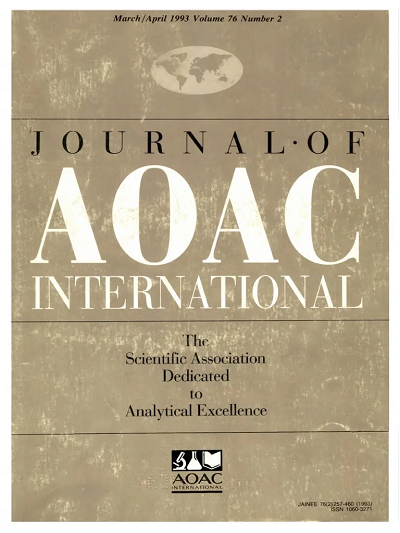通过横向流动检测法快速检测 SARS-CoV-2 的 6 对适配体-适配体的比较
IF 1.7
4区 农林科学
Q3 CHEMISTRY, ANALYTICAL
引用次数: 0
摘要
背景 SARS-CoV-2 对人类构成威胁。Spike(S)蛋白及其受体结合域(sRBD)被广泛用于快速检测。虽然实时反转录聚合酶链反应(rRT-PCR)是目前最常用的 SARS-CoV-2 分子检测方法,但抗原检测的快速检测方法始终是必要的。侧流检测法(LFA)是最常用的检测方法,具有稳定性和长保质期的适配体被用作捕获试剂。本研究旨在开发基于适配体对的 LFAs,用于肉眼检测 SARS-CoV-2 的抗原性。方法 以金纳米粒子(AuNPs)为标记,用 4 μM 和 8 μM 的探针和两种膜制备三种不同适配体的六种夹心模型,用于开发 LFAs。结果 8 μM 的探针浓度和 M2 膜对合成 sRBD 和来自鼻/咽拭子的 SARS-CoV-2 的识别效果最好,与检测抗体的 LFAs 相比,灵敏度为 100%,特异性为 93.3%。结论 我们开发的基于适配体对的条带检测法能在 5-6 分钟内用肉眼直接识别目标。研究还得出结论,适配体对、膜类型、检测缓冲液和探针浓度对 LFAs 检测 SARS-CoV-2 有重要作用。亮点 在为 LFAs 设计的 6 对适配体中,使用灵敏度和选择性最好的一对适配体检测了临床样本中的 SARS-CoV-2。所开发的 LFAs 可以替代传统的基于抗体的 LFAs 来检测 SARS-CoV-2。本文章由计算机程序翻译,如有差异,请以英文原文为准。
Comparison of 6 aptamer-aptamer pairs on rapid detection of SARS-CoV-2 by lateral flow assay
Background SARS-CoV-2 is a threat for humanity. Both the Spike (S) protein and its receptor binding domain (sRBD) are extensively used for the rapid detection. Although real time reverse transcription polymerase chain reaction (rRT-PCR) is mostly used method for the molecular detection of SARS-CoV-2, rapid assays for antigenic detection is always needed. Lateral flow assays (LFAs) are the most commonly used tests for this purpose and aptamers having stability and long shelf life are used as capture reagents. Objective This study aimed to develop the LFAs based on the aptamer pairs for the antigenic detection of SARS-CoV-2 with naked eye. Methods Gold nanoparticles (AuNPs) were used as label and six sandwich models by three different aptamers were prepared using 4 μM and 8 μM probes and two kinds of membranes for developing the LFAs. Results 8 μM probe concentration and M2 membrane showed the best recognition of both the synthetic sRBD and SARS-CoV-2 coming from the naso/oropharingeal swabs by designed LFAs as 100% sensitivity and 93,3% specifity compared to the antibody detecting LFAs. Conclusions Our developed strip assays based on aptamer pairs recognized the target, directly in a 5-6 minutes with naked eye. It was also concluded that aptamer pairs, membrane types, assay buffers and probe concentrations have significant role in the detection of SARS-CoV-2 by LFAs. Highlights The detection of SARS-CoV-2 in clinical samples was demonstrated with the best aptamer pairs, sensitively and selectively among the designed 6 aptamer pairs for LFAs. Developed LFAs can be an alternative method to the conventional antibody based LFAs for SARS-CoV-2 detection.
求助全文
通过发布文献求助,成功后即可免费获取论文全文。
去求助
来源期刊

Journal of AOAC International
医学-分析化学
CiteScore
3.10
自引率
12.50%
发文量
144
审稿时长
2.7 months
期刊介绍:
The Journal of AOAC INTERNATIONAL publishes the latest in basic and applied research in analytical sciences related to foods, drugs, agriculture, the environment, and more. The Journal is the method researchers'' forum for exchanging information and keeping informed of new technology and techniques pertinent to regulatory agencies and regulated industries.
 求助内容:
求助内容: 应助结果提醒方式:
应助结果提醒方式:


